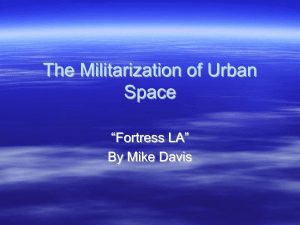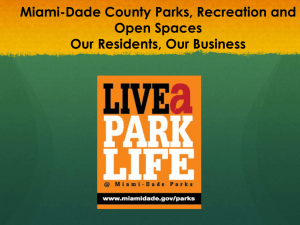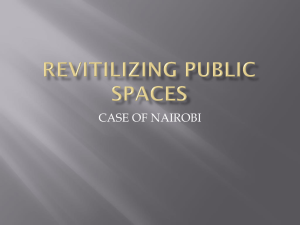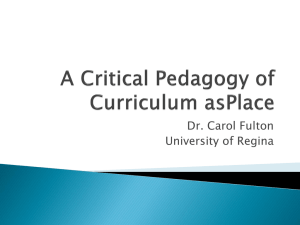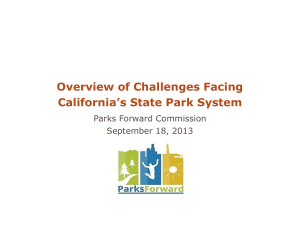Parks and open space - St. Francis Xavier Church , Panvel
advertisement
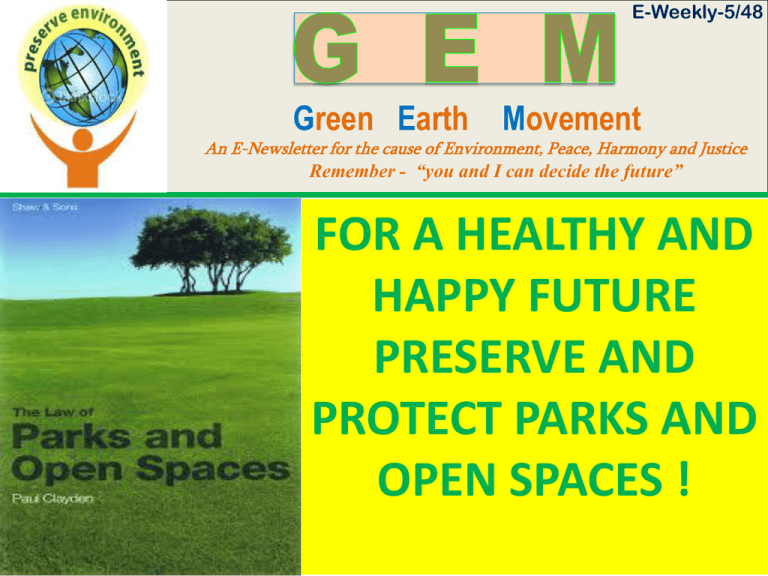
E-Weekly-5/48 Green Earth Movement An E-Newsletter for the cause of Environment, Peace, Harmony and Justice Remember - “you and I can decide the future” FOR A HEALTHY AND HAPPY FUTURE PRESERVE AND PROTECT PARKS AND OPEN SPACES ! EDITOR’S NOTE “The BMC has planned to develop Aarey Colony, one of the few green spaces left in the city, as a new development zone in its Development Plan (DP) for the next 20 years (2014-34). However, environmentalists have condemned the move saying it will only expose Aarey Colony to rampant development, which will result in loss of green cover”. (courtesy: Asian Age) In this context, this PowerPoint Presentation may help the readers to be enlightened on the need of open spaces. Father Felix Rebello, Editor DEFINITION Parks and open space refers to land that has been reserved for the purpose of formal and informal sport and recreation, preservation of natural environments, provision of green space and/or urban storm water management. Parks and open space vary in size, form and the functions that they perform. A strategic approach is needed in assessing the needs of a community and planning an open space network. Public open space is usually categorised into a hierarchy of neighbourhood, district and regional open space and can be used for either passive or active recreation. Neighbourhood parks provide for regular local use and may include: •small areas of open space that are accessible to local residents, generally providing for recreation such as children’s play and relaxation, which also can provide an identity and a sense of place for a community especially where it incorporates an important landscape feature or historic characteristic •playing fields for organised sport (from 1ha to 3ha in size) which can also be used for walking and informal activities, and •Linear parks linking areas of open space. These often follow drainage lines or environmental corridors and can incorporate off road shared pedestrian and cyclist paths. District and regional parks are larger and cater to the needs of a broader population. The types of parks may include: •district playing fields that provide for a range of active, organised sport and recreation such as football/soccer fields, cricket pitches, tennis courts, baseball fields and the like •waterfront and other regional parks for social gatherings, such as picnics, recreation and education, and •areas reserved for cultural or environmental retention (escarpments and areas of biodiversity value such as wetlands and bushland) that may provide some limited recreation opportunities, such as bird watching, picnicking and bushwalking. Open space often comes under pressure for development in existing neighbourhoods or is at risk of being undervalued and underprovided in the planning of new subdivisions. However, in some cases a strategic assessment will identify a need to reorientate or rationalise existing open space to overcome past planning mistakes and to address access and maintenance issues. An open space network should encourage more active lifestyles by offering a variety of safe and attractive spaces that are well distributed throughout a neighbourhood and are accessible and cater to the sporting and recreational needs of the community . Preferably public open space should attempt to cater for multiple users. For example, through landscaping and the addition of facilities, a sporting oval could be designed to cater for sportspeople, walkers, and children . There are numerous health benefits associated with access to public open space and parks. Access to vegetated areas such as parks, open spaces, and playgrounds has been associated with better perceived general health, reduced stress levels , with reduced depression and more walking. Moreover, there is a substantial body of evidence demonstrating that increased walking improves physical and mental health. Physical inactivity is a major public health risk. Worldwide, mental health is a leading cause of burden of disease. One study found that people who use public open spaces are three times more likely to achieve recommended levels of physical activity than those who do not use the spaces. Users and potential users prefer nearby, attractive, and larger parks and open spaces. More specifically, the benefits from participating in sport and physical activity include: 1] Improved physical health and wellbeing – with reduced risk of lifestyle related diseases, higher survival rate of other diseases, improved quality of life and long term health, and, in young people and children healthy growth and development. 2] Improved mental health – builds individual self-esteem and self-image, reduces stress, improves concentration and enhances memory and learning. 3] Enhanced social outcomes – encourages social interaction and development of social skills, improves social networks and social capital, increases community cohesion and pride, safer communities. 4] Reduced healthcare costs – improved physical health and the building of stronger families and communities helps lower health-care costs, reduces the costs of social intervention and plays a role in reducing crime and social dysfunction. Thus, improving access to public open space has the potential to increase levels of physical activity, and to have mental health benefits and reduce healthcare and other costs. 5] Public spaces also enrich lives by providing sites for festivals, celebrations, expressions of community identity, or simply a space to breath at leisure. 6] Children become the next generation of adults, and will ultimately reflect the conditions of life they currently experience. Open spaces liberate the ‘wild thing within’ but all forms of play help children develop their abilities, teaching them personal responsibility, and to thrive as a member of a team or community. Playgrounds increase civic engagement and solidarity. Encourage Amenity Design public open space so that it: •protects and enhances the environmental, cultural and heritage values of an area. •assists with place-making by building on the special attributes of an area, eg. hill tops, ridges, rocky outcrops, remnant vegetation, water features, views, vistas, and incorporating community art projects/public art. •is pleasant and welcoming, eg. through embellishments such as landscaping, park furniture (seats, drinking fountains) and lighting. •is well maintained and actively managed, and •is safe and perceived to be safe such as by providing lighting and areas that can be viewed by people. Accessibility Ensure accessibility with open space that is: •distributed throughout an area providing equitable access to all residents •easily accessible via public transport where appropriate •easily accessible via the walking and cycling network and with adequate bicycle parking facilities, and •connected where practicable with a Broader open space Network throughout the area. Useability Useability is ensured by open space that: •is of a sufficient size and shape to cater for its intended purpose, in most states minimum standards apply for the provision of open space •is adaptable, catering for multiple users and types of activities •for children, has access to facilities such as basketball hoops and running tracks which are associated with moderate to vigorous physical activity, and •is shared by a number of user groups, for example, school ovals could form part of the open space network and be available out of school hours for community use. Rule of thumb Design the open space network as an integral part of the urban structure and offer a variety of safe and attractive spaces that are well distributed throughout a neighbourhood and that are accessible, connected and cater to the sporting and recreation needs of the community. Avoid •Public open space not being integrated into a new development area. Rather it should be considered with potential users in mind in terms of the range of activities and location, and attention should be given to its detailed design. •Concentrating only on the quantity of open space provided. It is equally important to consider the quality of public open space and how it will be used, in order to maximise community value and its contribution to creating green spaces in the urban environment. MUMBAI SITUATION With a population growing towards 14 million, Mumbai’s citizens inhabit a compressed urban condition within a dense landscape of harsh social and economic divides. As one of the most densely populated cities in the world, the public domain is further compromised by a lack of public spaces. A citizen of Mumbai gets 1.1 square metre of open space against the international standard of 11 square metre per person. Only 6 percent of the total land in the city is made up of open public spaces. Out of this, 45 percent is partially or completely encroached upon. The urban fabric of Mumbai is thus characterized by two forms of ad-hoc growth. One fueled by squatters who cannot afford formal housing and are compelled to live in self-built organic settlements that are densely packed and infrastructurally under-served. The second, more dominant growth pattern is driven by private developers who are filling in the void left by the lack of planning, with shopping malls, office plazas and gated communities. While these are packaged into well-designed modules, they plug-in to the city in a similarly ad-hoc manner with little regard for infrastructure or open spaces. HOW TO PROTECT OPEN SPACES? 1] There are areas of the city that can be considered as open space, but are under constant threat of development. Within the city's limits are 37.3 sq. km of mangroves, 10.68 sq.km of salt pans, 13.35 sq. km of marshy areas and 46.5 sq. km of the Sanjay Gandhi National Park, for a total of 107.83 sq.km. Currently No Development Zones are allowed to be constructed on. These land should be reserved strictly under non buildable open space reservations. Once these lands are declared protected from any future development, the amount of open space per capita will be secured for our future. 2] Our second recommendation is to give custody/responsibility of the open spaces to the individual ward Office. Currently, playgrounds, recreation grounds and gardens are the responsibility of the Superintendent of Gardens, a centralized office within the BMC under the Department of Gardens and Zoo. 3] Lastly it is the opportune time for citizens groups and individuals to adopt an open space as purely non-buildable reservation. Once the city's open spaces are secure and a minimal level of physical intervention is made (benches, trash bins, lighting, fencing, etc.), they are prime opportunities for an ALM, housing society or cooperative or school to adopt these open spaces. Increasing or even maintaining the existing amount of public open space in Mumbai has and will continue to be a challenge in the city. Political will, public consciousness and pressure on decision makers and developers are the only tools available to ensure that Mumbai does not lose its precious public open spaces. This in turn will prevent several factors that negatively affect residents' health and restore the city's ecological balance. This educational PowerPoint Presentation (editable) is prepared by GEM Team (courtesy: internet). For other similar GEM PowerPoint Presentations on various environmental issues see next slide. These PPTs may be downloaded from our website www.stfrancisxavierpanvel.in The GEM PPTs can be creatively used for various groups like school/college students, NGOs, government officials, Church groups, SCC groups, housing society members and so on. Zero Garbage Solar Energy Junk Food Twenty Tips To Save Nature Plastic – a boon or bane? Green Passion Soft drink – A Health Hazard Waste to energy Rain Water Harvesting Eco-friendly Religions Happy Green Diwali Climate Change The future of Biodiversity Genetically Modified Foods Waste Water Treatment Give thanks, Give Life (Body, Organ, Tissue Donation) Organic Farming Waste to cooking gas Reduce, Reuse. Recycle Protect Mangroves Say NO to Bottled water Save Lakes and Ponds Forests are green lungs Coal Mining and Ecology Sin of Food Waste Climate change and Poverty Stop Water Pollution Carbon Footprints Parks and Open Spaces For Free Weekly GEM E-Newsletters visit – www.stfrancisxavierpanvel.in – every Friday. Go to GEM section, click GEM E-NEWSLETTERS

